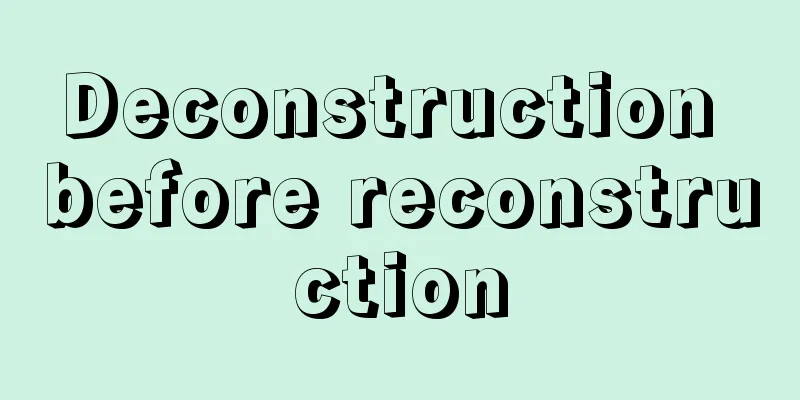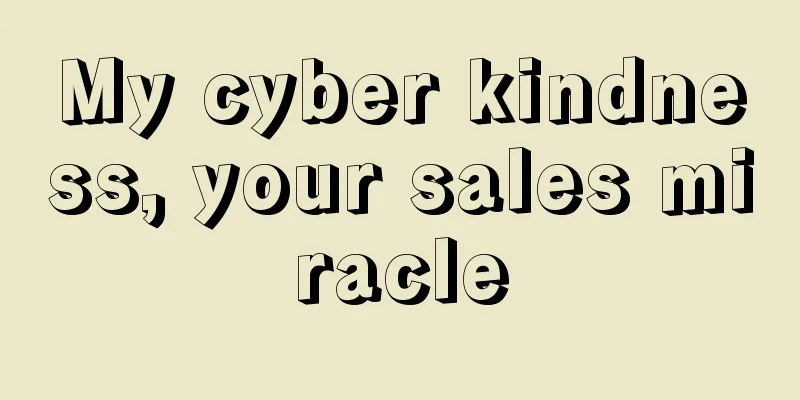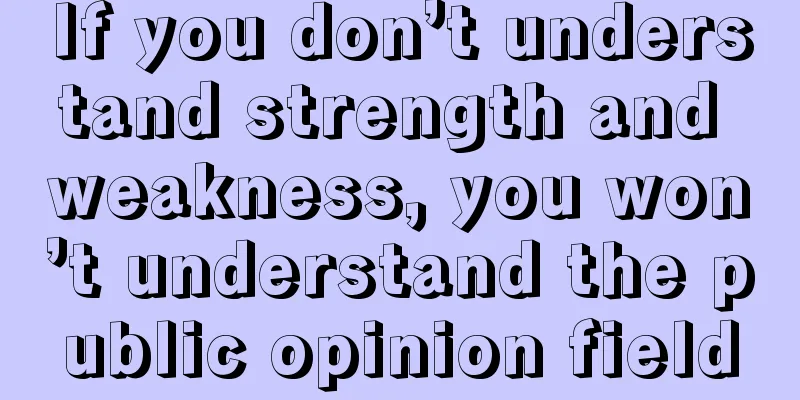Deconstruction before reconstruction

If you were to open a vegetable shop now, what would you choose? There are two stalls. Stall A is in a vegetable market, and stall B is also in a vegetable market, but there are two other vegetable markets nearby. Not surprisingly, most people will choose stall A because there is less competition and more opportunities to make money. In fact, some smart vendors will choose the second one. Isn’t it a bit strange? This incident happened near my home, and I learned a valuable lesson from it: problems are trapped in structures, and to solve problems, in addition to solving the problems themselves, you also need to look outside the structure. 01Why do you say that? Let me tell you two stories. The first one is about shopping: I recently wrote a note complaining about the vegetable market near my home. What I meant was: all the small shops around here are closed. The real estate developer didn't want to see empty shops, so he opened two more vegetable markets nearby. I was thinking, why did they have to open a vegetable market when they could have opened anything else? Was it intentional, or was it just to survive? I also said that Chinese people like to compete directly when doing business. If others do well, we just copy them. Foreign practices are different, and they know how to complement each other better. for example: If someone else opens a supermarket, they will consider selling some products that the supermarket does not have, or providing complementary services so that everyone can make money together. This is not groundless, there is a classic story from earlier years: This supermarket is the American Trader Joe's. It was founded by Joe Coulombe in Pasadena, California in 1967. Currently, it has 571 stores in 42 states across the United States and is one of the major grocery store chains in the United States. The things they sell are different from those in other supermarkets. They are either of good quality or have a high cost-performance ratio. So, I started to think: How can we make money if three markets are gathered together and each stall sells similar things? If they are in direct competition, won’t they all have to compete to see who has the lowest price and the best value for money? I soon discovered that I had understood it wrongly. These days, I chatted with vendors while shopping for groceries. One lady boss told me that the way they buy goods is the "37 principle". 30% of the goods are grown by themselves or come from greenhouses. These goods are not only fresh, but also low in cost and have relatively high profits. The remaining 70% are wholesaled from the Xinfadi market, so that the purchase can maintain a small profit. for example: Tomatoes are shipped from Tongzhou Yongle and sold at 3.5 yuan per catty. The quality is similar to those sold at 5 yuan per catty in the market. If customers are satisfied after buying them once, they will naturally buy them again next time. Not only selling vegetables, everyone is working hard to accumulate their own regular customers. There is a sign "Add WeChat friends" next to the stall. We will update the circle of friends every day and organize group purchases on weekends. Many young people are willing to make reservations. Oh, I understand. It turns out that profits can be mined in invisible places. In addition, I found a fish stall that was particularly popular. They were separated from their competitor by a spice shop, but customers clearly preferred them. I bought a fish out of curiosity and was going to ask why. But the owner gave me the answer when he asked me after the sale. He asked me how I was going to eat it when I got home? Steam or boil it? I said, steaming is better, after all, it is fresh. Unexpectedly, he then offered me some coriander. This was just the right amount of thoughtfulness and made me feel it was very valuable. Later I understood that if users want cheap prices, then we shouldn’t argue about the price and should focus on demonstrating other values. Although it may seem like direct competition on the surface, it is actually indirect competition. However, this has not solved the problem of my three vegetable markets being in turmoil. A vendor said that fierce competition has always existed, and the advantage of the three together is that there is a large flow of people, and everyone comes here to buy vegetables, so the repurchase rate becomes higher. This "market effect" actually helps everyone attract more community traffic around. Therefore, problems are trapped in structures, and a single perspective often limits us. 02The second story: Coincidentally, it’s also next to my doorstep. This time, it is on the left side of a commercial street. There used to be many shops here, such as M&G Stationery, Malatang, Lanzhou Ramen, Dumpling House, Western Restaurant and supermarket. This street has always had good business. Many office workers and migrant workers come here to eat at noon every day, and there are also many people who come here to eat skewers in the evening. But the shops on this street are a bit old and need to be renovated and upgraded; some businesses have moved away helplessly. Before moving away, I went to the ramen restaurant I often patronized and had one last bowl of noodles. The boss told me that they would move back after the renovation was completed in three months. It sounds like good news, but time flies. Three months have passed. Several shops have moved back as planned, and some have been replaced by new shops such as Lawson convenience stores and iced lemon tea. But business is not as prosperous as before, and there are almost no customers. Why is this happening? I have observed that in the past, all shops were small shops with simple door numbers and overall style, like a neighborhood shop. The prices were also affordable, which easily attracted customers. After the renovation, the shop doorplates became taller. These tall doorplates gave people a feeling that consumption was very expensive. Originally, office workers and migrant workers all went to a street farther away. Caption: A street that has abandoned its image of a small shop, photographed on 2024.7.28 I also went to several stores to experience it myself. Although the price was not expensive, the feeling was obviously different. Therefore, when the huge structure changes, the problem will be magnified or changed in form, resulting in only seeing the performance phenomenon. What is structure? Think of it like the frame of a house, which determines the shape and size of the house, as well as the overall function of the house. In different situations, the "framework" or "structure" also controls how things develop and the final result. The structure can be expressed in physical form, such as a real estate developer's requirement for a merchant's store to improve its performance; it can also be expressed in economic form, such as the vegetables in my house are cheaper than those in yours. It can also be a manifestation of consumer behavior, for example: most of the people who come to me to buy vegetables are young people, they pay attention to service attitude and don’t mind a slightly higher price. The success of a commercial street depends largely on the surrounding crowds and maintaining customers' continued repurchase. For the commercial street on the left, the upgrades to the house numbers and exteriors give people an illusion of high-endness. This approach ignores the most critical point, that is, there is no design centered on surrounding users, resulting in unsatisfactory actual results. For the commercial street selling vegetables on the right, the three vegetable markets are located in the same area. It seems that the configuration will inevitably lead to competition. In fact, the "market effect" leverages the surrounding resources and undoubtedly enhances the commercial vitality of the entire area. Therefore, structure determines how problems are formed, developed and solved. 03There is tremendous power for change hidden in structure. Learning how to identify and master structure is like a golden key to life. Education has taught us to regard unpleasant things as "problems" and then to solve them. In fact, when we create something, we do it to make something new come into being, which is completely opposite to the motivation of solving problems. Sometimes, when faced with a difficult problem, our first reaction is to solve it immediately. This hasty attitude is often not helpful and makes us more irritated. Einstein once said something very interesting: You can't find a solution at the same level where the problem arises; smart people solve problems, and truly smart people avoid problems. What does this mean? If we want to solve a problem thoroughly, we must improve our thinking level and look at the problem from a different perspective. for example: Vegetable and fish sellers will never be able to escape price wars if they simply compete on price; they have successfully shifted their focus from price to service quality and customer experience, thus creating a competitive advantage. In fact, they are taking advantage of this, but they just can't see the higher perspective. Systems scientist Russell Ackoff also shared a similar view, saying: Do you think the best approach is to solve the problem? Not necessarily. The smartest approach is to turn the problem into a non-problem. This means redesigning the environment in which the problem arose so that it goes away on its own. This is not only a smart approach, it also prevents the problem from happening again in the first place. To put it bluntly, real change is the creation of new structures; when the structure changes, the way of dealing with things will also change, which makes it easier to create important things. You know, all important progress in civilization is mostly achieved through innovation. The irony is that most people are not educated in creativity; the creative process itself is a completely new construct compared to the way we normally learn, and the education that cultivates innovators is completely different from the growth environment of most people. If we only regard creation as a tool to solve problems, we will never create anything truly important; only when the hidden structure truly changes, the path of least resistance will naturally guide us to our goals. Just like: if the riverbed doesn't change, the water will continue to flow along its original path. Philosopher Wittgenstein once mentioned that one should not confront reality head-on to change the status quo. The correct approach is to build a new model and let the old model become obsolete naturally. This means that true wisdom lies not only in solving problems, but in redefining problems and solutions in a completely new way; this kind of discernment can make outdated ways of doing things quickly become obsolete, and this is strategic success. Once you learn structural thinking, you will no longer ask "how to solve this annoying problem", but instead think about "what kind of structure can create the results I want". Obviously, the designer of the structure is high-dimensional. However, designing a structure and structuring are two different things. The former represents the creation of a new framework to achieve the ultimate goal; the latter represents the use of a systematic method to analyze and solve problems. 04Too theoretical? Let me give you an example: "Personal brand" is a very popular word. I have always been reluctant to talk about it because it is very difficult to build a personal IP. Coco Chanel, the founder of Chanel, once said: “Style is knowing who you are, what you want to say, and then not giving a damn about what others think. It is the core of personal branding.” The value of a person is determined by the few who are willing to pay the highest price for you. Note that it is the highest bid among the few. This price reflects the long-term value of your personal IP. Take commodities for example: Some brands have been on discount all year round, so many consumers only buy when the price drops and never at full price; Hermès, Chanel and LV are very protective of their brand image, their prices have been rising, and there are rarely large-scale public promotions. Their products themselves also have investment value. Take the Hermès Birkin bag as an example. Since its launch in the early 1980s, its average annual appreciation rate has been about 14%. It is now regarded as an investment product, and its performance has even exceeded the US S&P 500 index during the same period. Coco Chanel once said: The bravest thing to do is to think independently and then express your ideas boldly. To be irreplaceable, always be different. How can young people create IP without sufficient experience and knowledge? Gaudy moves will waste more time and energy, and eventually reduce themselves to promoting cheap brands. Improving and creating value itself seems easy, but it is also difficult. The essence lies in three cyclical actions: product, work, and content. Products solve the problem of commercialization; works and content solve the problem of influence, but to continuously produce valuable works, it is necessary to go deep into the industry and life and solve specific problems. There are many classic IPs. Laozi, one of the founders of the Taoist school, believed that “Tao follows nature”, which had a profound influence on China and even Southeast Asia. Wang Yangming’s unity of knowledge and action was like a tight hoop, influencing generations of businessmen. From the perspective of great people (IP), they put more energy into creating theoretical systems. If you understand this, you will understand the few people who are willing to pay the highest price for you. This highest price reflects the continued value of personal IP. Therefore, if you want to have high value, you must design your own structural system to stand out from the competition. You may say: "Designing structures sounds good, but in daily life, there is almost no opportunity to design structures. I am always busy solving one problem after another. It is really difficult. What should I do? Then accumulate: Structural Advantage. When you are doing the same thing as others, no matter how hard you try, you will eventually fall into the trap of "serving those who hold power in the system"; the harder you work and the more you do for them, the weaker your ability to gain power for yourself will be. To gain real power, you need to constantly think and practice: "How can I make a difference and occupy a unique position?" This takes time and patience. Because with differentiation, it is easier to stand out from the competition. For example, no one will compete with you for a 3-5 year opportunity. There are three reasons for this: First, most people do not have enough resources to persist; second, the effect of the opportunity may not be seen in the short term, and the results will not be fed back to you immediately; third, when people are uncertain, they will seek a sense of security, and they will often ask people around them: "What do you think of this opportunity?" to increase their confidence. I noticed that some of my friends have been struggling for several years but are still standing still. They made a big mistake: they never considered in which areas they could build advantages for sustainable growth. They often fantasize that they can surpass their competitors and gain huge rewards simply through hard work without any advantages. Everyone has a different starting point for building "structural advantages". They can start from their own interests and strengths. No matter how small, as long as they can accumulate, they can gradually accumulate small things into big ones in the chosen field, and it will become easier and easier. So, think about where you want to be in five years. This is the best way to design a structure, and it is also useful from a business perspective. SummarizeThe problem is trapped in the structure. Only by deconstructing can we reconstruct; only by identifying the huge structure can we detect the subtle problems hidden in it; once we understand the problem, we can gradually deconstruct everything. I hope you have the ability to jump out of the problem and see the structure. |
<<: 2024, the history of the collapse of the traffic network celebrity
>>: WeChat Ask a Question has a new feature: you can make money by writing answers!
Recommend
This collaboration with Luckin Coffee is definitely a step above Moutai’s reach!
In the past two days, Luckin Coffee launched a hot...
It is difficult to monetize advertising, so is it feasible for content agencies to build their own brands?
As it becomes increasingly difficult for content a...
10,000 words sorted | 35 essential models for brand marketing strategy
This article summarizes 25 global classic models a...
With so many hit dramas, how did Tencent's dramas become such a popular brand?
Why is Tencent Video so popular? The reason is tha...
Do I need to declare tax when I buy things on Amazon? How can I reduce the possibility of being taxed?
Nowadays, many people like to shop globally, and i...
Anti-IQ tax finally has traffic on Douyin
They do not engage in popular science, do not rega...
What is eBay direct warehouse? What are eBay's logistics methods?
For eBay merchants, after opening a store, they ne...
What are the cross-border payment app platforms? Tell you how to choose
With the continuous development of the global econ...
What does a wish operations assistant do?
Wish is a well-known global e-commerce platform th...
Taobao’s new regulations make it clear that it is more difficult to attract traffic to private domains!
With the release of Taobao’s new regulations, this...
How to set up the Shopee audience setting function? Why use it?
Shopee's contextual ads can prioritize merchan...
What is the eBay Vault program? Detailed answer
eBay has three operating modes: the first is aucti...
Is Shopify the same as Shopee? Is Shopify B2C or C2C?
There are many cross-border e-commerce platforms o...
A new generation of "Chinese New Year managers" learn about Chinese New Year on Xiaohongshu
With the development of the Internet and the chang...
Can “Liu Qiangdong” support JD Live as a host?
This article details the pros and cons of Liu Qian...









